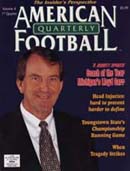Article CategoriesAFM Magazine
|
Closed Head Injuries in FootballAn examination of closed head injuries-what they are, how to recognize them, and how they can be prevented. First in a two-part series.by: Rod Smith AFM Staff Writer © More from this issue When his eight concussions in nine NFL seasons forced New York Jets wide receiver Al Toon to retire on November 27, 1992, the event was overshadowed by another, arguably more serious injury. Two days later, in a contest between the Jets and Kansas City Chiefs, teammate and defensive end Dennis Byrd suffered a fractured vertebra when he collided violently with teammate Scott Mersereau, leaving Byrd partially paralyzed and requiring surgery to stabilize his spine. The lack of national media coverage given to Toon's forced retirement did not, however, lessen the seriousness of the post-concussive effects endured by the player. Headaches, nausea, dizziness and bouts of vertigo, all left Toon-a three-time All-Pro selection-shaken, emotionally as well as physically. Despite the relative minor impact that had caused the blow,....The full article can only be seen by subscribers.
|
|
|||||||
| HOME |
MAGAZINE |
SUBSCRIBE | ONLINE COLUMNISTS | COACHING VIDEOS |
Copyright 2025, AmericanFootballMonthly.com
All Rights Reserved





